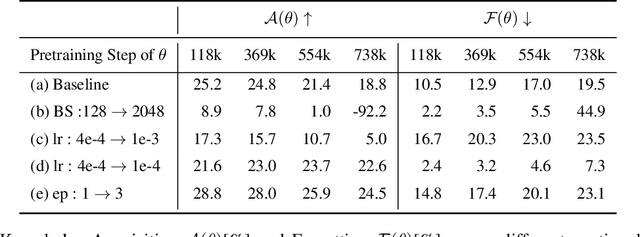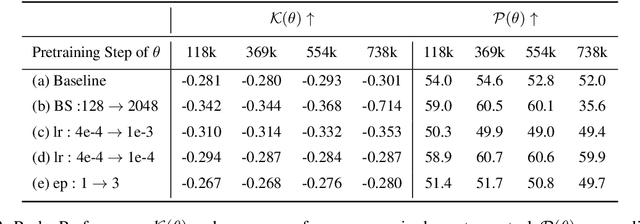Minjoon Seo
DSAI: Unbiased and Interpretable Latent Feature Extraction for Data-Centric AI
Dec 09, 2024Abstract:Large language models (LLMs) often struggle to objectively identify latent characteristics in large datasets due to their reliance on pre-trained knowledge rather than actual data patterns. To address this data grounding issue, we propose Data Scientist AI (DSAI), a framework that enables unbiased and interpretable feature extraction through a multi-stage pipeline with quantifiable prominence metrics for evaluating extracted features. On synthetic datasets with known ground-truth features, DSAI demonstrates high recall in identifying expert-defined features while faithfully reflecting the underlying data. Applications on real-world datasets illustrate the framework's practical utility in uncovering meaningful patterns with minimal expert oversight, supporting use cases such as interpretable classification. The title of our paper is chosen from multiple candidates based on DSAI-generated criteria.
Generative Context Distillation
Nov 24, 2024Abstract:Prompts used in recent large language model based applications are often fixed and lengthy, leading to significant computational overhead. To address this challenge, we propose Generative Context Distillation (GCD), a lightweight prompt internalization method that employs a joint training approach. This method not only replicates the behavior of models with prompt inputs but also generates the content of the prompt along with reasons for why the model's behavior should change accordingly. We demonstrate that our approach effectively internalizes complex prompts across various agent-based application scenarios. For effective training without interactions with the dedicated environments, we introduce a data synthesis technique that autonomously collects conversational datasets by swapping the roles of the agent and environment. This method is especially useful in scenarios where only a predefined prompt is available without a corresponding training dataset. By internalizing complex prompts, Generative Context Distillation enables high-performance and efficient inference without the need for explicit prompts.
Latent Action Pretraining from Videos
Oct 15, 2024



Abstract:We introduce Latent Action Pretraining for general Action models (LAPA), an unsupervised method for pretraining Vision-Language-Action (VLA) models without ground-truth robot action labels. Existing Vision-Language-Action models require action labels typically collected by human teleoperators during pretraining, which significantly limits possible data sources and scale. In this work, we propose a method to learn from internet-scale videos that do not have robot action labels. We first train an action quantization model leveraging VQ-VAE-based objective to learn discrete latent actions between image frames, then pretrain a latent VLA model to predict these latent actions from observations and task descriptions, and finally finetune the VLA on small-scale robot manipulation data to map from latent to robot actions. Experimental results demonstrate that our method significantly outperforms existing techniques that train robot manipulation policies from large-scale videos. Furthermore, it outperforms the state-of-the-art VLA model trained with robotic action labels on real-world manipulation tasks that require language conditioning, generalization to unseen objects, and semantic generalization to unseen instructions. Training only on human manipulation videos also shows positive transfer, opening up the potential for leveraging web-scale data for robotics foundation model.
How Does Vision-Language Adaptation Impact the Safety of Vision Language Models?
Oct 10, 2024



Abstract:Vision-Language adaptation (VL adaptation) transforms Large Language Models (LLMs) into Large Vision-Language Models (LVLMs) for multimodal tasks, but this process often compromises the inherent safety capabilities embedded in the original LLMs. Despite potential harmfulness due to weakened safety measures, in-depth analysis on the effects of VL adaptation on safety remains under-explored. This study examines how VL adaptation influences safety and evaluates the impact of safety fine-tuning methods. Our analysis reveals that safety degradation occurs during VL adaptation, even when the training data is safe. While safety tuning techniques like supervised fine-tuning with safety datasets or reinforcement learning from human feedback mitigate some risks, they still lead to safety degradation and a reduction in helpfulness due to over-rejection issues. Further analysis of internal model weights suggests that VL adaptation may impact certain safety-related layers, potentially lowering overall safety levels. Additionally, our findings demonstrate that the objectives of VL adaptation and safety tuning are divergent, which often results in their simultaneous application being suboptimal. To address this, we suggest the weight merging approach as an optimal solution effectively reducing safety degradation while maintaining helpfulness. These insights help guide the development of more reliable and secure LVLMs for real-world applications.
Knowledge Entropy Decay during Language Model Pretraining Hinders New Knowledge Acquisition
Oct 02, 2024



Abstract:In this work, we investigate how a model's tendency to broadly integrate its parametric knowledge evolves throughout pretraining, and how this behavior affects overall performance, particularly in terms of knowledge acquisition and forgetting. We introduce the concept of knowledge entropy, which quantifies the range of memory sources the model engages with; high knowledge entropy indicates that the model utilizes a wide range of memory sources, while low knowledge entropy suggests reliance on specific sources with greater certainty. Our analysis reveals a consistent decline in knowledge entropy as pretraining advances. We also find that the decline is closely associated with a reduction in the model's ability to acquire and retain knowledge, leading us to conclude that diminishing knowledge entropy (smaller number of active memory sources) impairs the model's knowledge acquisition and retention capabilities. We find further support for this by demonstrating that increasing the activity of inactive memory sources enhances the model's capacity for knowledge acquisition and retention.
RouterRetriever: Exploring the Benefits of Routing over Multiple Expert Embedding Models
Sep 04, 2024Abstract:Information retrieval methods often rely on a single embedding model trained on large, general-domain datasets like MSMARCO. While this approach can produce a retriever with reasonable overall performance, models trained on domain-specific data often yield better results within their respective domains. While prior work in information retrieval has tackled this through multi-task training, the topic of combining multiple domain-specific expert retrievers remains unexplored, despite its popularity in language model generation. In this work, we introduce RouterRetriever, a retrieval model that leverages multiple domain-specific experts along with a routing mechanism to select the most appropriate expert for each query. It is lightweight and allows easy addition or removal of experts without additional training. Evaluation on the BEIR benchmark demonstrates that RouterRetriever outperforms both MSMARCO-trained (+2.1 absolute nDCG@10) and multi-task trained (+3.2) models. This is achieved by employing our routing mechanism, which surpasses other routing techniques (+1.8 on average) commonly used in language modeling. Furthermore, the benefit generalizes well to other datasets, even in the absence of a specific expert on the dataset. To our knowledge, RouterRetriever is the first work to demonstrate the advantages of using multiple domain-specific expert embedding models with effective routing over a single, general-purpose embedding model in retrieval tasks.
TWLV-I: Analysis and Insights from Holistic Evaluation on Video Foundation Models
Aug 21, 2024Abstract:In this work, we discuss evaluating video foundation models in a fair and robust manner. Unlike language or image foundation models, many video foundation models are evaluated with differing parameters (such as sampling rate, number of frames, pretraining steps, etc.), making fair and robust comparisons challenging. Therefore, we present a carefully designed evaluation framework for measuring two core capabilities of video comprehension: appearance and motion understanding. Our findings reveal that existing video foundation models, whether text-supervised like UMT or InternVideo2, or self-supervised like V-JEPA, exhibit limitations in at least one of these capabilities. As an alternative, we introduce TWLV-I, a new video foundation model that constructs robust visual representations for both motion- and appearance-based videos. Based on the average top-1 accuracy of linear probing on five action recognition benchmarks, pretrained only on publicly accessible datasets, our model shows a 4.6%p improvement compared to V-JEPA (ViT-L) and a 7.7%p improvement compared to UMT (ViT-L). Even when compared to much larger models, our model demonstrates a 7.2%p improvement compared to DFN (ViT-H), a 2.7%p improvement compared to V-JEPA~(ViT-H) and a 2.8%p improvement compared to InternVideo2 (ViT-g). We provide embedding vectors obtained by TWLV-I from videos of several commonly used video benchmarks, along with evaluation source code that can directly utilize these embeddings. The code is available on "https://github.com/twelvelabs-io/video-embeddings-evaluation-framework".
Investigating How Large Language Models Leverage Internal Knowledge to Perform Complex Reasoning
Jun 27, 2024



Abstract:Despite significant advancements, there is a limited understanding of how large language models (LLMs) utilize knowledge for reasoning. To address this, we propose a method that deconstructs complex real-world questions into a graph, representing each question as a node with parent nodes of background knowledge needed to solve the question. We develop the DepthQA dataset, deconstructing questions into three depths: (i) recalling conceptual knowledge, (ii) applying procedural knowledge, and (iii) analyzing strategic knowledge. Based on a hierarchical graph, we quantify forward discrepancy, discrepancies in LLMs' performance on simpler sub-problems versus complex questions. We also measure backward discrepancy, where LLMs answer complex questions but struggle with simpler ones. Our analysis shows that smaller models have more discrepancies than larger models. Additionally, guiding models from simpler to complex questions through multi-turn interactions improves performance across model sizes, highlighting the importance of structured intermediate steps in knowledge reasoning. This work enhances our understanding of LLM reasoning and suggests ways to improve their problem-solving abilities.
Cognitive Map for Language Models: Optimal Planning via Verbally Representing the World Model
Jun 21, 2024Abstract:Language models have demonstrated impressive capabilities across various natural language processing tasks, yet they struggle with planning tasks requiring multi-step simulations. Inspired by human cognitive processes, this paper investigates the optimal planning power of language models that can construct a cognitive map of a given environment. Our experiments demonstrate that cognitive map significantly enhances the performance of both optimal and reachable planning generation ability in the Gridworld path planning task. We observe that our method showcases two key characteristics similar to human cognition: \textbf{generalization of its planning ability to extrapolated environments and rapid adaptation with limited training data.} We hope our findings in the Gridworld task provide insights into modeling human cognitive processes in language models, potentially leading to the development of more advanced and robust systems that better resemble human cognition.
On Efficient Language and Vision Assistants for Visually-Situated Natural Language Understanding: What Matters in Reading and Reasoning
Jun 17, 2024Abstract:Recent advancements in language and vision assistants have showcased impressive capabilities but suffer from a lack of transparency, limiting broader research and reproducibility. While open-source models handle general image tasks effectively, they face challenges with the high computational demands of complex visually-situated text understanding. Such tasks often require increased token inputs and large vision modules to harness high-resolution information. Striking a balance between model size and data importance remains an open question. This study aims to redefine the design of vision-language models by identifying key components and creating efficient models with constrained inference costs. By strategically formulating datasets, optimizing vision modules, and enhancing supervision techniques, we achieve significant improvements in inference throughput while maintaining high performance. Extensive experiments across models ranging from 160M to 13B parameters offer insights into model optimization. We will fully open-source our codebase, models, and datasets at https://github.com/naver-ai/elva .
 Add to Chrome
Add to Chrome Add to Firefox
Add to Firefox Add to Edge
Add to Edge